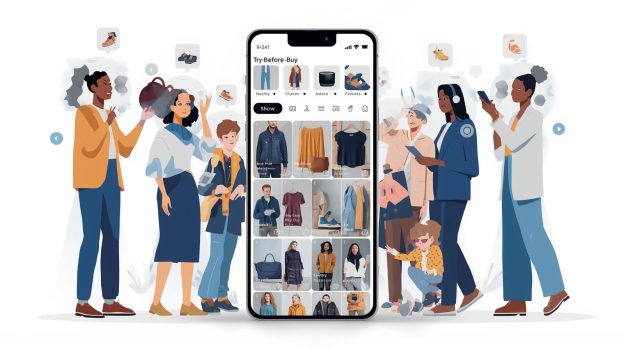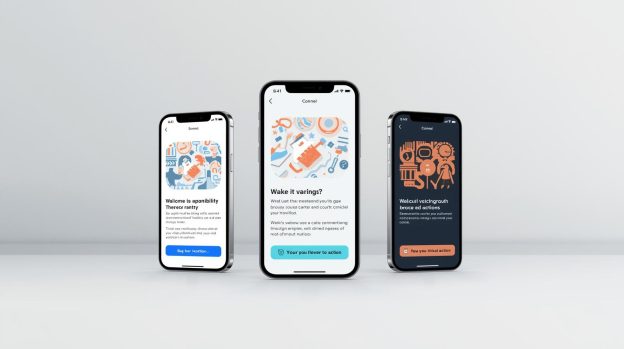AR in Retail Apps: Try-Before-You-Buy Experiences That Convert

Online shopping is what everyone’s after in this fast-paced, growing ecommerce environment. The only thing holding shoppers back is having to experience and try on the products before buying. Well, there is no holding back now because of the lively and immersive augmented reality experiences. Now, with AR, shoppers can virtually try on the products like furniture fitting into your living room, foundation and concealer according to skin tone, glasses, dresses, etc. Many brands have already leveraged AR-integrated mobile applications, which allow users to try products and get an immersive experience to strengthen their decision-making. Let’s explore how AR is transforming the retail shopping experience for consumers, enabling them to shop and try on products virtually anywhere.
Why are Retail Business Owners After Integrating AR in Shopping Mobile Apps? Let’s Find Out
Retail business owners are after creating an immersive experience for consumers where they can virtually try on products and see how they look and feel, so that they can make informed decisions. The AR integration in shopping mobile applications not only allows shoppers to try on products but has also become a “standard” in fields like furniture, beauty, and fashion. The AR integration in shopping mobile applications builds shoppers’ confidence in purchasing products. The key benefits retailers see by integrating augmented reality into mobile applications are:
- The AR feature in mobile applications is one of the most attention-grabbing functionalities that users see. Even if they are not activating the AR feature to try on products virtually, they still notice the display showing the AR feature, which results in improved traffic on the website and higher store entries.
- There is a huge contribution of technology integration, like AR, in mobile applications to improving brand image among consumers. Integrating augmented reality into a mobile app positions your business as engaging and innovative, which sets you apart from your competitors in a similar market niche. It’s a very future-forward approach where shoppers get to experience what the product will look like even before bringing it home.
- Another benefit that retailers gain from integrating AR into shopping mobile apps is improved customer engagement. If customers linger longer on the platform to try on the products, they are more likely to be swayed to purchase them. Hence, this creates deeper engagement and gives the brand more time to convince users to buy the product.
Top Retail Mobile Apps with AR Functionality: How They Impact Shopping Experience
#1. Lenskart: Try Glasses Virtually
The first example of a shopping mobile app with AR is Lenskart. The Lenskart application uses an AR feature to let shoppers virtually try on glasses to see how they look on their face. Customers can virtually check the fit, look, and appeal of glasses on them and potentially have other comparison points by trying on different glasses through the mobile app. It improves their engagement on the application and creates competitive differentiation for Lenskart, where consumers look at the brand as an innovative leader in the industry.
#2. IKEA: How the Product Feels in Customers’ Environment
IKEA is a comprehensive e-commerce brand dealing in furniture, bathroom utilities, kitchen utilities, dining room utilities, living room utilities, smart lighting, organisation, terrace utilities, etc. Being a versatile brand, dealing in various e-commerce segments, IKEA uses augmented reality in its application to show how the product will look in the customer’s environment. For example, if you plan to buy a couch from IKEA, you can view how it will look in your living room. Through the AR feature on the IKEA place app, you can virtually identify the fit of the furniture in your living room space with approximately 98% accuracy.
To Sum Up
Some other examples of AR in mobile apps are Dulux paint, where you can discover how the paint colour looks on your walls. There is Sephora, from where you can buy cosmetic products and evaluate your skin tone to choose products like foundation, concealer, etc. AR in mobile apps is changing the customer shopping experience and making their shopping journey extremely smooth. Retail business owners see reduced product return rates and increased conversions. If you are in the retail business and wish to stand out from your competitors, integrating technologies like AR and AI into shopping mobile apps can improve your customer retention and conversion rate. We encourage you to book a consultation with our developers at VerveLogic, one of the top mobile app development companies in California, to look after your mobile app development needs.




